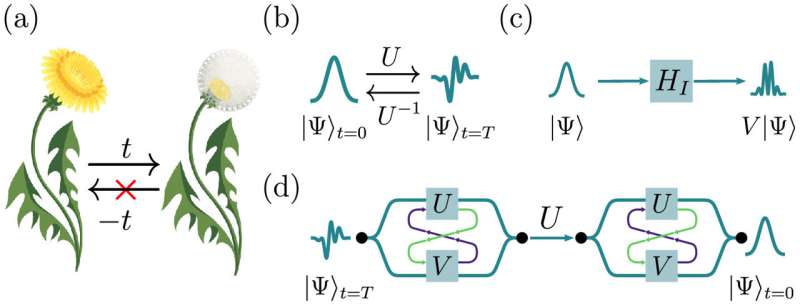This article has been reviewed according to Science X's editorial process and policies. Editors have highlighted the following attributes while ensuring the content's credibility:
fact-checked
peer-reviewed publication
trusted source
proofread
How to reverse unknown quantum processes

In the world around us, processes appear to follow a certain time-direction: Dandelions eventually turn into blowballs. However, the quantum realm does not play by the same rules. Physicists from the University of Vienna and IQOQI Vienna have now shown that for certain quantum systems, the time-direction of processes can be reversed. This demonstration of a so-called rewinding protocol has been published in Optica.
Everyday life is full of changes that are well understood, yet practically impossible to reverse; for example, the metamorphosis of a dandelion into a blowball. However, one could imagine undoing this transformation, step by step, if one knew precisely how each molecule in the plant moved in time. In the quantum realm the problem gets even trickier: One of the core principles of quantum physics is that simply observing a system causes it to change.
This makes it impossible, even in principle, to track a system's change in time and reverse the process. However, at the same time, the laws of quantum mechanics also open up new possibilities such as universal rewinding protocols. These allow for reversing changes in a quantum system without knowing what they were.
In a collaboration between the University of Vienna and IQOQI Vienna, experimental physicists headed by Philip Walther have successfully implemented such a universal rewinding protocol developed by theoretical physicists led by Miguel Navascués. Combining this novel theoretical protocol with an intricate optical setup, the group showed that it is indeed possible to revert changes of a quantum system. For this, they employed ultra-fast optical fiber components and free-space interferometers arranged as a quantum switch.
They successfully reversed the time evolution of a single photon without knowing how it changed in time, or even what its initial and final states were. "Remarkably, this protocol does not even require the nature of the interactions with the quantum system to be known," says Peter Schiansky, first author of the publication.
Their universal rewinding protocol is optimally efficient in its runtime and can be extended to succeed with arbitrarily high probability. The proof that rewinding protocols exist in this general form and that they are technically feasible contributes to our understanding of fundamental quantum mechanics. In the future, these protocols could become a useful tool in quantum information technologies.
More information: P. Schiansky et al, Demonstration of universal time-reversal for qubit processes, Optica (2022). DOI: 10.1364/OPTICA.469109
Journal information: Optica
Provided by University of Vienna





















